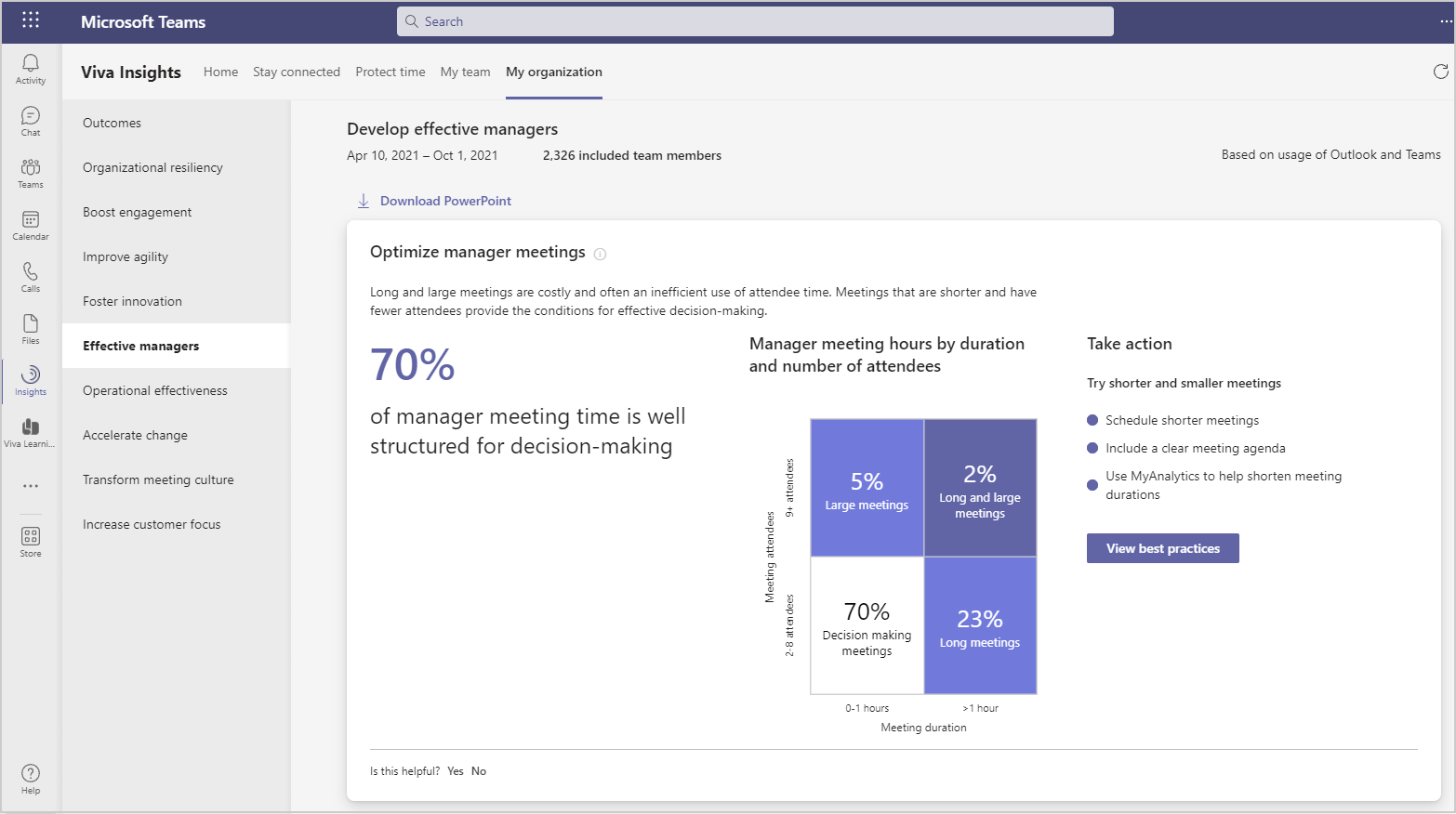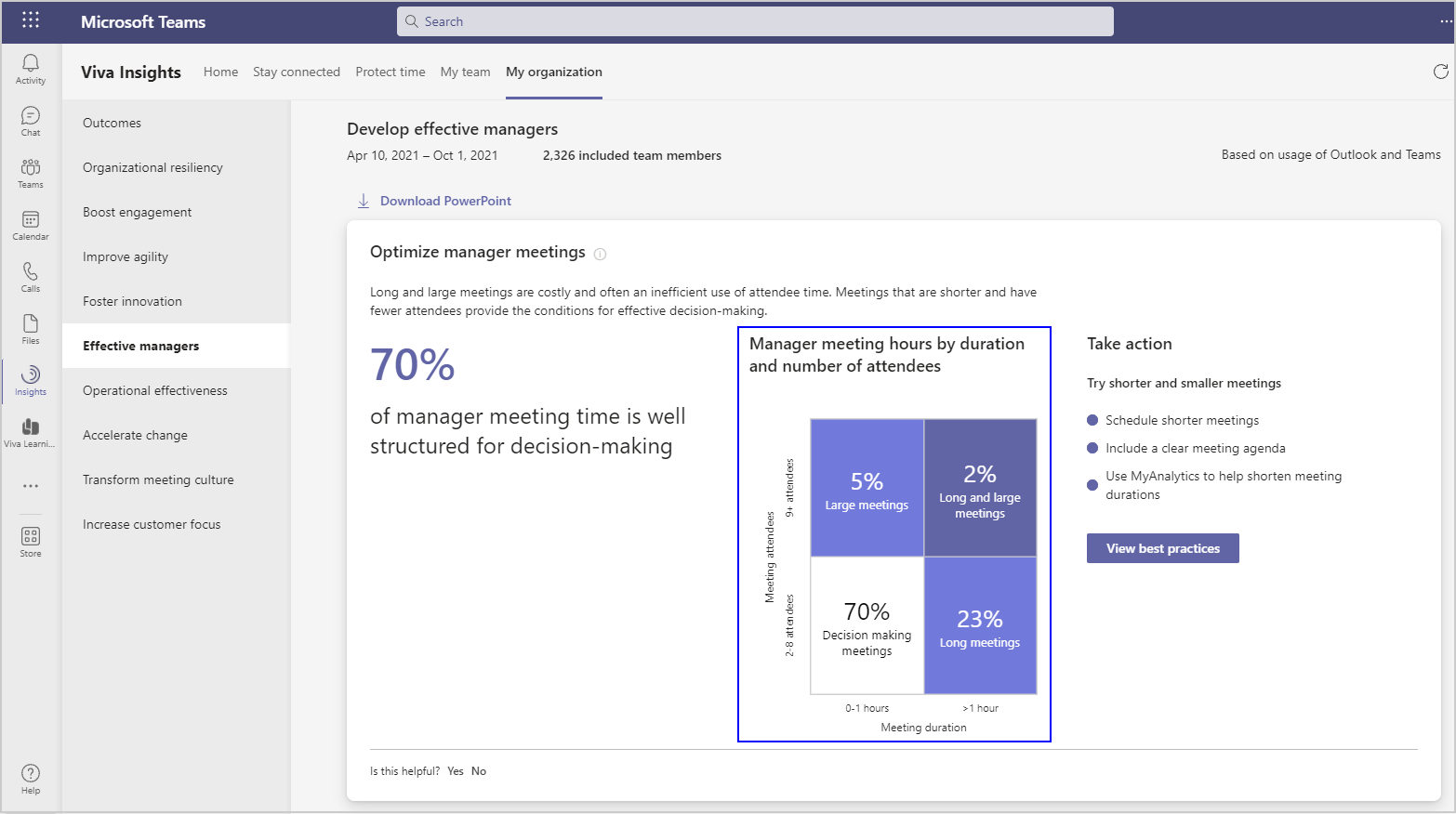Effective managers with Viva Insights
Important
This article is for the legacy Workplace Analytics app and does not reflect functionality available on the updated Viva Insights platform. Access current documentation for Viva Insights advanced insights here: advanced insights documentation.
Managers have a large impact on employee engagement, development, and performance, and are pivotal for driving organizational change. Each of the behaviors listed show how your organization compares with others based on industry research and your specific organizational data.
Microsoft Viva Insights has a My organization page that shows leader's collaboration data about their team. The outcomes include data about developing Effective managers.

Calculations
The following are the percentage insights, their underlying metrics, and a little about the calculations used for them.

| Behavior | Percentage insight | Metrics | Calculations |
|---|---|---|---|
| Optimize manager meetings | Percentage of your managers' meetings that are well structured for making decisions | Long and large meetings and meeting hours | The percentage of managers who spend over 50 percent of meeting hours in long or large meetings. Long meetings are longer than one hour and large meetings have more than eight attendees. The percentages are calculated weekly and averaged for the entire time period. |
| Protect manager capacity | Percentage of managers who are working after hours for more than one hour each week | After-hours collaboration | The percentage of managers who spend more than one hour collaborating through email, calls, instant messages, and meetings outside of working hours. This percentage is calculated weekly and averaged over the entire time period. |
| Promote coaching and development | Percentage of employees who have less than one hour of 1:1 time with their managers each month | Meeting hours with manager 1:1 | The percentage of employees who spend less than one hour of coaching time with their managers each month. This percentage is calculated monthly and averaged over the entire time period. |
| Empower employees | Percentage of employees who have a majority of their meetings attended by their manager | Meeting hours with manager and meeting hours | The percentage of employees who spend over 50 percent of their meeting hours with their manager in attendance. This percentage is calculated weekly and averaged over the entire time period. |
| Foster connectivity | The percentage of managers who have significant opportunity for new connections | Diverse ties | The percentage of managers with unique connections as compared to those with fewer unique connections. This insight is based on the number of diverse ties that managers have outside their skip-level managers' organizations and compares that with the total number of managers in the measured population. This percentage is calculated weekly and averaged over the last six months. |
The following defines the organizational data shown in the visual behavioral insights.

| Behavior | Visual insight | Definitions |
|---|---|---|
| Optimize manager meetings | Manager meeting hours by duration and number of attendees | Shows the percentage of manager meetings based on their type, including: Large meetings with more than eight attendees, long meetings that are longer than one hour, long and large meetings with more than eight attendees and are longer than one hour, and decision-making meetings with between two and eight attendees and are less than one hour in duration. These percentages are calculated weekly and averaged over the entire time period. |
| Protect manager capacity | Distribution of after-hours collaboration from managers | Percentage of managers based on their weekly after hours collaboration. They are divided into those who spend less than one hour, between one to five hours, and more than five hours collaborating after hours. These percentages are calculated weekly and averaged over the entire time period. |
| Promote coaching and development | Distribution 1:1 time with managers each month | Shows the percentage of employees based on their monthly average number of meeting hours with managers 1:1. They are divided into employees who have no 1:1s, between zero and one hour, and more than one hour of 1:1s with their manager in a month. These percentages are calculated monthly and averaged over the entire time period. This graph also uses the influence metric. |
| Empower employees | Distribution of manager-employee coaching relationships | Uses the average time employees spend with their managers in 1:1s and the percentage of meeting hours with the manager in attendance. The different manager-employee coaching relationships are grouped by employee time percentages that are weekly averages based on the monthly calculations:
|
| Foster connectivity | Managers and cross-group connectivity | Shows an organizational network graph that represents managers with many as compared to a few unique connections, and compares them with all other employees based on their network connections within your organization. This insight enables you to see the impact manager networks have on engagement and the networks of their direct reports. Use these insights to build more effective manager training programs that improve engagement and broader organizational connectivity. |
Best practices
To take action on an outcome, you can select View best practices to see a list of recommendations for it. This section describes why each of the following behaviors matter and the top best practices that can help managers be more effective.
- Optimize manager meetings
- Protect manager capacity
- Promote coaching and development
- Empower employees
- Foster connectivity
Optimize manager meetings
Long and large meetings are costly and often an inefficient use of attendee time. Meetings that are shorter and have fewer attendees provide the conditions for effective decision-making.
The condensed guide to running meetings explains a few new ideas that can help make your meetings more effective, such as if "you want people to have the opportunity to contribute, you need to limit attendance." Ways to optimize meetings:
- Use Teams and OneNote to share meeting notes about decisions and action items as an alternative way to keep your team informed.
- Use Manager insights within Advanced insights to help identify ways to support team behavior.
For more best practices and how to set team meeting rules and policy, see Best practices for meetings.
Protect manager capacity
Long hours and the pressure to always be available can lead to burnout. The amount of time managers spend collaborating outside of business hours can be an indicator of burnout risk, even as teams embrace flexibility.
Based on research presented in the Why unplugging from work is more work than we think: "New research and our growing understanding about human behavior tell us two things for certain: that unplugging is more necessary than ever, and that true unplugging is not a single action but a social agreement — a culture shift that employees and companies must create together." Ways to support wellbeing:
- Use Quiet time to view after-hours activity and encourage disconnection from work after the day is done.
- Use the Inline suggestions in Outlook to automatically delay email delivery to align with coworkers' configured working hours.
For more best practices and how to define and share working hours, see Best practices for wellbeing.
Promote coaching and development
Manager one-on-one (1:1) time can improve engagement and job performance, while a lack of manager coaching can contribute to employee disengagement and attrition. According to the research referenced in What great managers do daily: "A Gallup study found that at least 70 percent of the variance in employee engagement scores is driven by who the boss is."
One of the top best practices for promoting coaching and development is to require that managers schedule recurring 1:1 meetings with their direct reports for 30 minutes at least twice a month and hold them accountable for achieving that goal. See Catch up with your team for help with scheduling and managing your 1:1s.
For more best practices and how to develop a 1:1 conversation series, see Best practices for manager coaching.
Empower employees
When managers empower their employees to make decisions and tackle new challenges, it provides growth opportunities for employees while freeing up time for managers to get work done.
How to boost your team’s productivity explains that "helping your team manage its time well is a critical factor for its success." Ways to increase information sharing:
- Use Teams and OneNote to share meeting notes about decisions and action items as an alternative way to keep your team informed.
- Use Manager insights within Advanced insights to identify ways to support team behavior.
For more best practices and how to set team meeting rules and policy, see Best practices for meetings.
Foster connectivity
Managers with unique connections across the organization can provide their teams with access to new and varied information or find unique intersections that magnify the impact of their teams' work.
In the Empowering your employees to empower themselves article: "Your employees understand their jobs. They know their tasks, roles, and functions within the organization, and it’s time for you to let them do what they need to do to get the job done." Ways to foster connectivity:
- Create cross-team communities for people with similar interests to share ideas, knowledge, and resources. This can also be done using Teams channels.
- Enable and use the Viva Insights Outlook add-in and Teamwork to add colleagues to your Important people list, receive suggestions to meet, reminders to respond to emails, and complete tasks for these contacts. And urge your team to do the same.
- Create a shared Teams channel to strengthen connectivity through channel interactions about projects, strategic topics, and goals to enable information sharing, brainstorming, and team building.
For more best practices and ways to open your network to your team, see Best practices for manager connectedness.